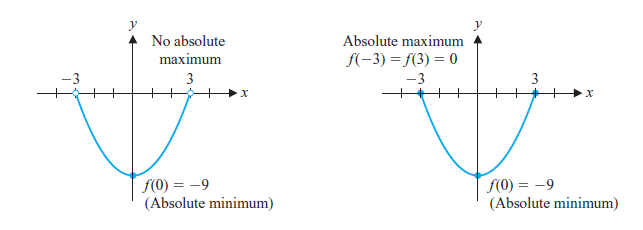Proof of Lagrange’s Mean Value Theorem
Statement: let f(x) be a function defined on [a,b] such that:
i) it is continuous on [a,b]
ii) it is differentiable on (a,b)
Then , there exist a real number C (a,b) such that
=\frac{f(b)-f(a)}{b-a}})
Proof : Proof of MVT follows from the Rolle’s theorem. Let (a,f(a)) and (b,f(b)) be the two points lying on the function f(x). Slope of line connecting these two points would be given as…
-f(a)}{b-a})
Equation of line passing through point (a,f(a)) having slope as above , would be given as
-f(a)}{b-a}(x-a)+f(a))
Let g(x) denote the vertical difference between point (x,f(x)) and (x,y) on that line, therefore
g(x) = f(x)-y
![\dpi{120} g(x)=f(x)-\left [\frac{f(b)-f(a)}{b-a}(x-a)+f(a) \right ]](https://latex.codecogs.com/gif.latex?\dpi{120}&space;g(x)=f(x)-\left&space;[\frac{f(b)-f(a)}{b-a}(x-a)+f(a)&space;\right&space;])
Since f(x) is continuous over [a,b] , g(x) is also continuous over same interval. Furthermore f(x) is differentiable over interval (a,b), g(x) is also differentiable over same interval (a,b). Therefore g(x) fulfills the criteria of Rolle’s theorem , that means there exist a point c∈(a,b) such that f ‘(c)=0.
=f'(x)-\frac{f(b)-f(a)}{b-a}(1-0)+0)
=f'(c)-\frac{f(b)-f(a)}{b-a})
Since g'(c)=0 ,we conclude that,
-\frac{f(b)-f(a)}{b-a})
=\frac{f(b)-f(a)}{b-a})
Hence the proof .
While checking the conditions for Mean value theorem , following results are helpful.
- A polynomial function is everywhere continuous and differentiable.
- Exponential function, sine and cosine functions are everywhere continuous and differentiable.
- Logarithmic function is continuous and differentiable in its domain.
- The sum, difference, product and quotient of two continuous and differentiable functions is also continuous and differentiable.
- Tan(x) is not continuous at

- |x| is continuous but not differentiable at x=0.
Example 1: Verify mean value theorem for the function
f(x)=x^3 -3x^2 +2x on interval [0, ½] .
Solution: Since f(x) is a polynomial function and we know that polynomial function is continuous and differentiable everywhere. So f(x) is continuous on [0, ½] and differentiable on interval (0, ½). Thus both the conditions of Mean Value theorem are satisfied.
So, there must exist atleast one real number C such that C (0, ½)
=\frac{f(\frac{1}{2})-f(0)}{\frac{1}{2}-0})
=3x^2-6x+2)
f’(c) = 3c^2 -6c +2
Also , f(1/2)= 1/8 -3/4 +1 =3/8
f(0) = 0
Using all values into the MVT formula , we get

3c^2-6c+2 = ¾
12c^2- 24c +5 = 0 [multiply both sides with 4]
Using quadratic formula to solve this quadratic equation, we get…
)
Out of these two values only  lies in the given domain.
lies in the given domain.
Hence Mean Value Theorem is verified.
Example 2: A marathoner ran 26 mile, city marathon in 2 hr and 15 min. Like all other runners, he started from a stationary position. During last 5 meters, his leg cramped. He fell down and had to roll across the finish line. Prove that atleast twice, the runner was running at exactly 11 mph.
Solution: Here position function S(t) is a continuous and differentiable function of time t. Which means MVT can be applied here. Since runner start from 0 and stops at finishing line after 2 hours 15 min (2.25 hrs), we have :
=0)
=26)
Average velocity is given as:
=\frac{26-0}{2.25-0}=11.56)
MVT guarantees that runner is running at a speed of 11.56 mph atleast once during his run for 2 hours and 15 min. Since he started at a velocity of 0, reached at a velocity of 11.56 mph and then return back to 0 velocity at finishing line, he must have crossed the velocity of 11mph atleast twivce during his run.
Note: Mean Value Theorem is not applicable to every function.
Here are few examples where MVT is not applicable.
Example 3: Discuss the applicability of Lagrange’s mean value theorem for the following functions.
a) f(x) = |x| on [-1,1]
b) f(x) = 1/x on [-1,1]
Solution:
a) f(x)= |x| is continuous everywhere so it is continuous at [-1,1] . But it is not differentiable on given domain as derivative doesn’t exist at x=0 for f(x)=|x|.
Since second conditions of Mean value theorem is not met , so MVT is not applicable to this function.
b) f(x)= 1/x is not continuous at x=0 which lie on interval [-1,1]. Therefore it is not differentiable at x=0 .
Since both conditions are not met on the given domain so MVT is not applicable to this function on given domain [-1,1]
Practice problems:
- Determine all the numbers c which satisfy the conclusions of the Mean Value Theorem for the following function.
=x^{3}+2x^{2}-x) on [-1,2]
on [-1,2]
- Using mean value theorem, find a point on the curve

defined on the interval [2,3] where the tangent is parallel to the chord joining the end points of the curve.
Answers:
- C=0.7863
)
[called power rule of integration]
[answer]








